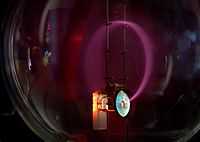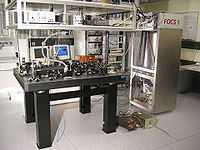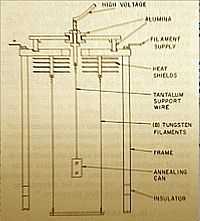Electron beam heating

“Free electrons in vacuum can be influenced by electric and magnetic fields [so] as to form a fine beam. At the spot of collision of the beam with the particles of the solid-state matter, most portion of the kinetic energy of electrons is transferred into heat. The main advantage of this method is the possibility of very fast local heating, which can be precisely electronically (computer) controlled. The high concentration of power in a small volume of matter, which can be reached in this way results in very fast increase of temperature in the spot of impact causing the melting or even evaporation of any material, depending on working conditions. This makes the electron beam an excellent tool in many applications.”[1]
Emissions
"Electron beams can be generated by thermionic emission, field emission or the anodic arc method. The generated electron beam is accelerated to a high kinetic energy and focused towards the [target]. When the accelerating voltage is between 20 kV – 25 kV and the beam current is a few amperes, 85% of the kinetic energy of the electrons is converted into thermal energy as the beam bombards the surface of the [target]. The surface temperature of the [target] increases resulting in the formation of a liquid melt. Although some of incident electron energy is lost in the excitation of X-rays and secondary emission, the liquid [target] material evaporates under vacuum."[2]
Liquid objects
“Any material can be melted by an electron beam in vacuum. This source of heat is absolutely clean, as well as the vacuum environment, so the purest materials can be produced in electron beam vacuum furnaces. For the production or refinement of rare and refractory metals the vacuum furnaces are of smaller volume, but for steels large furnaces with capacity in metric tons and electron beam power of megawatts are operated in industrialized countries.”[1]
"In the electron-beam method, the source is heated by an electron beam with an energy up to 15 keV."[3]
"Electron Beam Physical Vapor Deposition -- In which the material to be deposited is heated to a high vapor pressure by electron bombardment in "high" vacuum."[3]
Sun
"One of [...] the outstanding problems of the outer atmosphere of the Sun is the identification of the physical mechanisms that give rise to the eruption of solar flares."[4]
There is a "hydrodynamic response of the solar atmosphere to the injection of an intense beam of electrons [as described] in a numerical simulation of a solar flare."[4]
"The hydrodynamics is predicted [...] and the geometric form is of a semi-circular loop having its ends in the photosphere. [...] the loop is filled at supersonic speed with plasma at temperatures characteristic of flares. At the same time a compression wave is predicted to propagate down towards the photosphere. After the heating pulse stops, the plasma that has risen into the loop, starts to decay and return to the condition it was in before the pulse started."[4]
The "impulsive phase of a flare [may be] initiated by an electron beam (having a power-law energy spectrum down to some minimum energy) depositing its energy in a model atmosphere representing the pre-flare condition."[4]
There may be "a magnetic field parallel to the electron beam, and sufficiently strong that the electrons and subsequent flare plasma are contained within the beam dimensions, and transport negligible thermal energy in transverse directions."[4]
The "pre-flare atmosphere is [...] for the chromosphere with a suitable extension into the corona."[4]
An "input beam pulse of 1011 erg cm-2 s-1 for 10 s is capable of filling a loop structure with plasma at a peak temperature of over 30 million degrees K, with associated flare velocities of over a thousand kilometers per second. Associated with this upward flaring material, is a compression wave moving towards the photosphere, and attaining particle densities of up to 1014 cm-3."[4]
Coronal clouds
Def. a cloud, or cloud-like, natural astronomical entity, composed of plasmas at least hot enough to emit X-rays is called a coronal cloud.
As of December 5, 2011, "Voyager 1 is about ... 18 billion kilometers ... from the [S]un [but] the direction of the magnetic field lines has not changed, indicating Voyager is still within the heliosphere ... the outward speed of the solar wind had diminished to zero in April 2010 ... inward pressure from interstellar space is compacting [the magnetic field] ... Voyager has detected a 100-fold increase in the intensity of high-energy electrons from elsewhere in the galaxy diffusing into our solar system from outside ... [while] the [solar] wind even blows back at us."[5]
The source of heat that brings the coronal cloud near the Sun hot enough to emit X-rays may be an electron beam heating effect due to "high-energy electrons from elsewhere in the galaxy diffusing into our solar system from outside"[5].
Earth
"[L]ow-altitude regions of downward electric current on auroral magnetic field lines are sites of dramatic upward magnetic field-aligned electron acceleration that generates intense magnetic field-aligned electron beams within Earth’s equatorial middle magnetosphere."[6]
Jupiter
"Field-aligned equatorial electron beams [have been] observed within Jupiter’s middle magnetosphere. ... the Jupiter equatorial electron beams are spatially and/or temporally structured (down to <20 km at auroral altitudes, or less than several minutes), with regions of intense beams intermixed with regions absent of such beams."[6]
Technology

"Technology is the making, usage, and knowledge of tools, machines, techniques, crafts, systems or methods of organization in order to solve a problem or perform a specific function."[7]
"It can also refer to the collection of such tools, machinery, and procedures. Technologies significantly affect human as well as other animal species' ability to control and adapt to their natural environments."[7]
Electron Beam Furnaces
“An electron beam furnace (EB furnace) is a type of vacuum furnace employing high-energy electron beam in vacuum as the mean for delivery of heat to the material being melted. It is one of the electron beam technologies. Electron beam furnaces are used for production and refining of high-purity metals (especially titanium, vanadium, tantalum, niobium, hafnium, etc.) and some exotic alloys.[8] The EB furnaces use a hot cathode for production of electrons and high voltage for accelerating them towards the target to be melted. An alternative for an electron beam furnace can be an electric arc furnace in vacuum. Somewhat similar technologies are electron beam melting and electron beam welding.”[9]
Electron beam furnace designs

"The filament cage [in an ultra high vacuum furnace on the right] was made of eight tungsten wires symmetrically placed around the sample to minimize azimuthal temperature gradients in the samples. The samples were hung from a high-voltage tantalum wire. When heated, the filaments emitted electrons that were accelerated toward the sample by the high voltage."[10]
Original research
- See also: Original research inquiry and Research
Hypothesis:
- All or a portion of the photosphere is being heated by electron bombardment; i.e., electron beam heating.
- See also: Control groups, Proof of concept, and Proof of technology
See also
References
- 1 2 "Electron beam technology, In: Wikipedia". San Francisco, California: Wikimedia Foundation, Inc. June 24, 2012. Retrieved 2012-06-30.
- ↑ Dgray (January 17, 2008). "Materials Science and Engineering/Doctoral review questions/Daily Discussion Topics/01162008, In: Wikiversity". Retrieved 2013-07-21.
- 1 2 18.55.6.103 (February 7, 2008). "Materials Science and Engineering/Diagrams/Device Fabrication Processes, In: Wikiversity". Retrieved 2013-07-19.
- 1 2 3 4 5 6 7 P. MacNeice, A. Burgess, R. W. P. McWhirter, & D. S. Spicer (February 1984). "A numerical model of a solar flare based on electron beam heating of the chromosphere". Solar Physics 90 (02). pp. 357–82. Bibcode:1984SoPh...90..357M. doi:10.1007/BF00173963. Retrieved 2014-06-14.
- 1 2 Steve Cole, Jia-Rui C. Cook, and Alan Buis (December 2011). "NASA's Voyager Hits New Region at Solar System Edge". Washington, DC: NASA. Retrieved 2012-02-09.
- 1 2 Barry H. Mauk and Joachim Saur (October 26, 2007). "Equatorial electron beams and auroral structuring at Jupiter". Journal of Geophysical Research 112 (A10221): 20. doi:10.1029/2007JA012370. http://www.agu.org/journals/ja/ja0710/2007JA012370/figures.shtml. Retrieved 2012-06-02.
- 1 2 "Technology, In: Wikipedia". San Francisco, California: Wikimedia Foundation, Inc. October 9, 2013. Retrieved 2013-10-10.
- ↑
- ↑ "Electron beam furnace, In: Wikipedia". San Francisco, California: Wikimedia Foundation, Inc. April 14, 2011. Retrieved 2012-06-30.
- ↑ R. E. Einziger, J. N. Mundy, and H. A. Hoff (January 15, 1978). "Niobium self-diffusion". Physical Review B 17 (2): 440-8. http://prb.aps.org/abstract/PRB/v17/i2/p440_1. Retrieved 2013-07-21.
External links
- African Journals Online
- Bing Advanced search
- Google Books
- Google scholar Advanced Scholar Search
- International Astronomical Union
- JSTOR
- Lycos search
- NASA/IPAC Extragalactic Database - NED
- NASA's National Space Science Data Center
- Office of Scientific & Technical Information
- PubChem Public Chemical Database
- Questia - The Online Library of Books and Journals
- SAGE journals online
- The SAO/NASA Astrophysics Data System
- Scirus for scientific information only advanced search
- SDSS Quick Look tool: SkyServer
- SIMBAD Astronomical Database
- SIMBAD Web interface, Harvard alternate
- Spacecraft Query at NASA.
- SpringerLink
- Taylor & Francis Online
- Universal coordinate converter
- Wiley Online Library Advanced Search
- Yahoo Advanced Web Search
| ||||||||||||||||||||||||||||||||||||||
| |||||||||||||||||||||||||||||||||||||||||
![]() This is a research project at http://en.wikiversity.org
This is a research project at http://en.wikiversity.org
| |
Educational level: this is a research resource. |
| |
Resource type: this resource is an article. |
| |
Resource type: this resource contains a lecture or lecture notes. |
| |
Subject classification: this is an astrophysics resource. |
| |
Subject classification: this is a technology resource . |